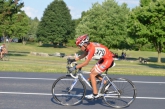Hematopoietic Stem And Progenitor Cells Sustain Inflammation And Promote Relapse In The AML Niche

Project Goal:
Project Update 2024:
Acute myeloid leukemia (AML) is the second most common type of blood-forming cancer among children. Despite novel therapeutics advancements, at least 1 in 5 children still suffer from incomplete cancer cell elimination and relapse. Recent research shows evidence that inflammation in the bone marrow (BM) is a significant factor in driving leukemic persistence, but the underlying biology that sustains inflammation in patients’ BM microenvironment remains not well understood. Our studies to date have shed light on the involvement of HSPC hematopoietic stem and progenitor cells (HSPCs), traditionally known as bystanders in AML pathogenesis, plays a contributing role in the AML microenvironment. Utilizing two mouse AML models, we show that: 1)HSPC exhibit inflammatory signaling in both AML microenvironment; 2) AML cells can secrete nanometer-sized signaling molecules, known as extracellular vesicles (EVAML), to incite inflammation in HSPCs. More recently, we demonstrated using human models that human AML cancer cells can also secrete these nanometer-sized signaling molecules and trigger inflammation in human BM HSPCs. Experiments are currently underway to understand whether these inflammatory insult on HSPCs imprint long-term memory in these cells that may change how they respond to future stressors. Understanding how AML reconfigures the HSPCs to fuel relapse has broad applicability independent of AML subtypes and enables us to generate new scientific knowledge that can help with the development of new treatment approaches aimed at impeding relapse.
Final Project Update 2025:
Our studies to date have demonstrated that hematopoietic stem and progenitor cells (HSPCs), a cell population that are conventionally thought as bystanders in AML pathogenesis, plays a contributing role in the AML microenvironment. Specifically, our finding now suggests that AML force HSPCs to secrete molecules that can promote inflammation, creating an environment that is more favorable to cancer cells. Moreover, we further found that AML reprograms HSPCs long-term to express signals that changes how they respond to subsequent stimuli and potentially promote AML. Understanding how AML reprograms the HSPCs to fuel relapse has broad applicability independent of AML subtypes and enables us to generate new scientific knowledge that can help with the development of new treatment approaches aimed at impeding relapse.

